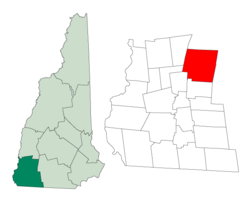Stoddard, New Hampshire
| Stoddard, New Hampshire | ||
|---|---|---|
| Town | ||

Stone Arch Bridge
|
||
|
||
 Location in Cheshire County, New Hampshire |
||
| Coordinates: 43°04′43″N 72°06′52″W / 43.07861°N 72.11444°WCoordinates: 43°04′43″N 72°06′52″W / 43.07861°N 72.11444°W | ||
| Country | United States | |
| State | New Hampshire | |
| County | Cheshire | |
| Incorporated | 1774 | |
| Government | ||
| • Board of Selectmen | John Halter, Chair Stephen McGerty Margo Santoro |
|
| • Town Administrator | James Coffey | |
| Area | ||
| • Total | 53.0 sq mi (137.3 km2) | |
| • Land | 50.9 sq mi (131.8 km2) | |
| • Water | 2.1 sq mi (5.5 km2) 4.02% | |
| Elevation | 1,427 ft (435 m) | |
| Population (2010) | ||
| • Total | 1,232 | |
| • Density | 23/sq mi (9.0/km2) | |
| Time zone | Eastern (UTC-5) | |
| • Summer (DST) | Eastern (UTC-4) | |
| ZIP code | 03464 | |
| Area code(s) | 603 | |
| FIPS code | 33-73700 | |
| GNIS feature ID | 0873725 | |
| Website | www |
|
Stoddard is a town in Cheshire County, New Hampshire, United States. The population was 1,232 at the 2010 census.
Between 1842 and 1873, the town was home to four glass manufacturers. The glass produced by these works, now known as Stoddard glass, is noted for its deep amber colors and design. Stoddard glass products are highly prized by collectors.
This territory was first granted in 1752 to Colonel Sampson Stoddard of Chelmsford, Massachusetts, and others as Monadnock Number 7. It was known locally as Limerick before being incorporated as Stoddard in 1774, in honor of Colonel Stoddard.
Colonel Stoddard was appointed to survey southwestern New Hampshire by the colonial government, receiving several land grants for the service. One of his surveying assistants was Benjamin Pierce, father of U.S. President Franklin Pierce. Colonel Stoddard never lived in the town of Stoddard.
The town was first settled in 1768 by John and Martha Taggart, immigrants from Derry, Ireland. Three years later, the Richardson family joined the Taggarts in Stoddard. By 1774, the town had 24 residents.
The first census taken in Stoddard, in 1790, reported 701 residents. The town's first schoolhouses were built in 1792. The first post office was established in 1822; Isaac Duncan was the first Postmaster.
In 1800, Stoddard's 1,148 residents outnumbered those of the nearby county seat of Keene. During Stoddard's glass-manufacturing years, 800 people were employed by the industry. After the Stoddard glass industry ended in the early 1870s, the town's population declined; by 1960, the census recorded 146 residents. As of 2010[update], the town had 1,232 residents.
Between 1840 and 1873, Stoddard was a center of glass manufacturing, home to four glass factories whose products are prized by collectors today. The town's abundant forests fed the industry's need for the 1,200 °F (650 °C) temperatures necessary to melt sand into glass. Stoddard also had plenty of clear, fine sand. The sand's trace minerals gave Stoddard glass its unique hues: manganese produced the olive green and amber colors most closely associated with Stoddard glass, and oxide of gold created a red-amber glass.
...
Wikipedia

